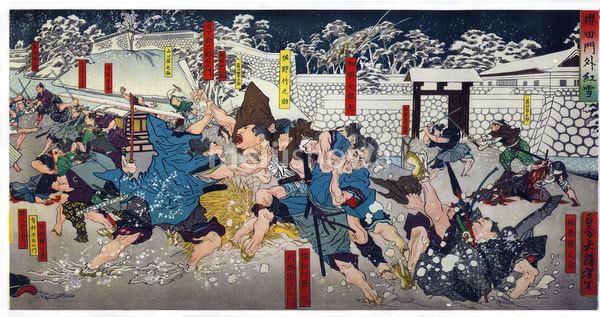Start date March 24, 1860 | ||
 | ||
The Sakuradamon Incident (桜田門外の変, Sakuradamon-gai no Hen, or 桜田門の変 Sakuradamon no Hen) was the assassination of Japanese Chief Minister (Tairō) Ii Naosuke (1815–1860) on 24 March 1860 by rōnin samurai of the Mito Domain, outside the Sakurada Gate of Edo Castle.
Contents
Context
Ii, a leading figure of the Bakumatsu period and a proponent of the reopening of Japan after more than 200 years of seclusion, was widely criticized for signing the 1858 Treaty of Amity and Commerce with the United States Consul Townsend Harris and, soon afterwards, similar treaties with other Western countries. From 1859, the ports of Nagasaki, Hakodate and Yokohama became open to foreign traders as a consequence of the Treaties.
Ii was also criticized for reinforcing the authority of the shogunate against regional daimyos through the Ansei Purge. Naosuke made strong enemies in the dispute for the succession of Shogun Tokugawa Iesada, and because he forced retirement on his opponents, specifically the retainers of Mito, Hizen, Owari, Tosa, Satsuma and Uwajima.
These policies generated strong sentiment against the Shogunate, especially among proponents of the Mito school.
Assassination
The assassination took place outside the Shogun's Edo Castle in Edo (modern Tokyo), just as Ii was reaching the premises. Ii had been warned about his safety, and many encouraged him to retire from office, but he refused, replying that "My own safety is nothing when I see the danger threatening the future of the country".
A total of 17 Mito rōnin ambushed Ii together with Arimura Jisaemon (有村次左衛門), a samurai from Satsuma Domain. While an attack at the front drew the attention of the guards, a lone assassin fired one shot into the palanquin containing Ii, with a Japanese-made Colt 1851 Navy Revolver, which had been copied from the firearms that Commodore Matthew Perry had given the shogunate as gifts. Drawing the injured and likely paralyzed Ii out, Arimura decapitated Ii and then committed seppuku.
The conspirators carried a manifesto on themselves, outlining the reason for their act:
Accounts of the violent event were sent via ship across the Pacific to San Francisco and then sped by pony express across the American West. On June 12, 1860 the The New York Times reported that Japan's first diplomatic mission to the West received the news about what happened in Edo.
Consequences
The popular upheaval against foreign encroachment and assassination of Ii forced the Bakufu to soften its stance, and to adopt a compromise policy of Kōbu Gattai ("Union of the Emperor and the Shogun") suggested by Satsuma Domain and Mito Domain, in which both parties vied for political supremacy in the years to follow. This soon amplified into the violent Sonnō Jōi ("Revere the Emperor, Expel the Barbarians") movement.
For the following years until the fall of Bakufu in 1868, Edo, and more generally the streets of Japan, would remain notably hazardous for Bakufu officials (see attack on Andō Nobumasa) and foreigners alike (Richardson murder), as the Sonno Joi movement continued to expand. According to Sir Ernest Satow: "A bloody revenge was taken on the individual [Ii], but the hostility to the system only increased with time, and in the end brought about its complete ruin".
The conflict reached its resolution with the military defeat of the Shogunate in the Boshin war, and the installation of the Meiji restoration in 1868.
